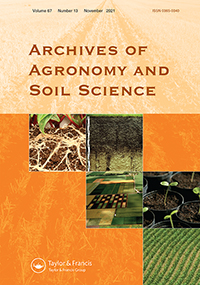Ver ítem
- xmlui.general.dspace_homeCentros e Institutos de InvestigaciónCIAP. Centro de Investigaciones AgropecuariasInstituto de Investigación Animal del Chaco SemiáridoArtículos científicosxmlui.ArtifactBrowser.ItemViewer.trail
- Inicio
- Centros e Institutos de Investigación
- CIAP. Centro de Investigaciones Agropecuarias
- Instituto de Investigación Animal del Chaco Semiárido
- Artículos científicos
- Ver ítem
Glomalin contribution to soil organic carbon under different pasture managements in a saline soil environment
Resumen
The glomalin produced by arbuscular mycorrhizal fungi has beneficial effects on soils. We studied the vertical profile of glomalin-related soil protein (GRSP) in pasturelands grown under saline soils and exposed to different management practices. Treatments included haying and grazing of Chloris gayana subject to either N-fertilization or not. We measured mycorrhizal colonization, spores, root biomass, total GRSP, GRSP-carbon (GRSP-C), organic carbon (OC)
[ver mas...]
The glomalin produced by arbuscular mycorrhizal fungi has beneficial effects on soils. We studied the vertical profile of glomalin-related soil protein (GRSP) in pasturelands grown under saline soils and exposed to different management practices. Treatments included haying and grazing of Chloris gayana subject to either N-fertilization or not. We measured mycorrhizal colonization, spores, root biomass, total GRSP, GRSP-carbon (GRSP-C), organic carbon (OC) and total nitrogen (TN). In the meanwhile, we also developed a mathematical procedure to fit continuous power functions to binned soil data. Power decay functions adjusted excellently well the measured data across the 1-meter soil profile. Meaningful increases of root biomass, OC, TN, GRSP and GRSP-C values were associated with grazing and fertilization. Particularly, GRSP-C averaged 1,134 kg C ha−1 at the beginning experiments and increased significantly up to 1,261 kg C ha−1 in grazed and fertilized pastures at the end of the study period. Carbon accounted for between 17% and 50% of GRSP, representing in turn 0.52–1.62% of SOC stock. So, a tropical perennial grass can contribute to the carbon stock in saline soils by promoting production of GRSP. This contribution increases when inputs and cycling of nutrients are enhanced (grazing and N-fertilization).
[Cerrar]

Autor
Banegas, Natalia Romina;
Dos Santos, Daniel Andrés;
Guerrero Molina, Fernanda;
Albanesi de Garay, Ada Susana;
Pedraza, Raúl;
Fuente
Archives of Agronomy and Soil Science (Published online: 23 Oct 2020)
Fecha
2020-10-23
Editorial
Taylor & Francis
ISSN
0365-0340
1476-3567 (online)
1476-3567 (online)
Formato
pdf
Tipo de documento
artículo
Palabras Claves
Derechos de acceso
Restringido
 Excepto donde se diga explicitamente, este item se publica bajo la siguiente descripción: Creative Commons Attribution-NonCommercial-ShareAlike 2.5 Unported (CC BY-NC-SA 2.5)
Excepto donde se diga explicitamente, este item se publica bajo la siguiente descripción: Creative Commons Attribution-NonCommercial-ShareAlike 2.5 Unported (CC BY-NC-SA 2.5)

